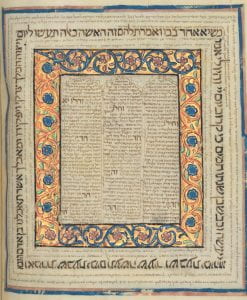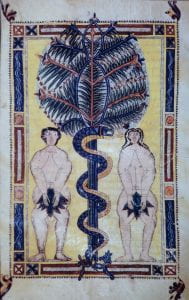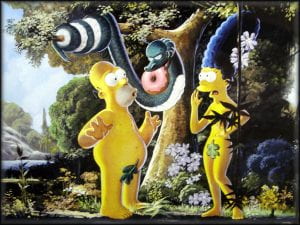Medieval Iberia was a hotbed of cross-cultural medieval literary activity. Jewish writers adapted Arabic poetics to give birth to a new Hebrew poetry. Muslim poets penned elaborate Arabic poems based on popular Spanish lyrics. Christian writers pioneered the use of the vernacular to tell Saints’ lives and write court histories. One tradition all three religions had in common was the Hebrew Bible: all three groups retold its stories in both their classical (Latin, Hebrew, Arabic) and vernacular languages. Medieval Iberians of all three religions participated in a common culture of biblical retellings that fused the doctrines of Islam, Judaism, and Christianity with the languages and cultures common to all three groups.

They have this in common
(Cloisters Bible, Castile, 14th c. Source: wikimedia.org)
In all of these retellings we see the influence of the unique circumstances of the Medieval Iberian coexistence (sometimes peaceful, at other times violent) of Islam, Judaism, and Christianity in the creation of a specifically Iberian Biblical storyworld. The creators and audiences lived in a world in which the three traditions were conscious of one another and competed for supremacy: their visions of the Biblical world were at once a product of their distinct religions and of the shared reality in which they lived.
I’ve written previously on the General estoria’s (13th c.) retelling of the Song of Songs, the Abraham and Sarah story, and more generally on the influence of rabbinic literature on the emergent vernacular fiction in the General estoria. In this series of posts I’d like to both narrow the focus of each to a single episode, and broaden the scope to include multiple Iberian sources from Jewish, Muslim, and Christian traditions.

Escorial Beatus
(Escorial, Biblioteca Monasterio, Cod. & II. 5) (source: wikimedia.org)
The story of Adam and Eve addresses in narrative form some of the most fundamental human social issues, from family life to the establishment of an agricultural society. The tale of the awareness gained by eating the fruit of the tree of knowledge of good and evil and subsequent expulsion from the garden is an allegory for the development from a hunter-gatherer to an agricultural society, technology, and the complications that this changes precipitates.
Jewish sources frame the Adam and Eve story as the blueprint for the human relationship with God, with creation, and as a model for heterosexual family life, and to a lesser extent to explain the role of human error and its consquences. Muslim sources emphasize Adam’s role as the first prophet in a line that end with Muhammad. Christian sources follow the Church’s doctrine of supersessionism, by which Christian readings of the Hebrew Bible point toward redemption in Christ.
Here I’d like to take a look at three versions of the tale of the expulsion from Eden, from the General Estoria (Castile, 13th c.), the Compendi historial de la biblia (Catalonia, 15th c.), and the Misteri d’Adam i Eva (Valencia, 15th-16th c.). In these works we see very different approaches to brining Biblical narrative to vernacular audiences, and get some sense of how Jewish, Muslim, and Chrstian traditions of the Hebrew Bible shared space in the Medieval Iberian biblical imagination.

Retellings
“Simpsons Bible Stories” (The Simpsons, Season 10, Episode 18, 1999) (source: wikimedia.org)
The General estoria is the universal history of Alfonso X, begun in the mid-thirteenth century and completed by Alfonso’s son Sancho IV at the end or the thirteenth or beginning of the fourteenth century. As part of its history of the world from the earth’s creation to the time of Jesus it includes large sections of a number of biblical books, supplementing the biblical text primarily with the twelfth-century biblical interpretation of French scholastic Petrus Comestor, titled Storia scholastica, and with material from Josephus’ Antiquities of the Jews, but also with material drawn from Muslim scholarship, Jewish biblical commentary, and a wide selection of Christian apocrypha.
The chief concern of the compilers of the General estoria seems to be to enrich the telling of the tale with historical and geographical information, but also with details that explain the motivations of the characters and that flesh out the details of the material world in which they live.

“and clothed them”
Raquel Welch and John Richardson in One Million Years B.C.(dir. John Chaffey, 1966) (source: Chroniques du Cinephile Stakhanoviste)
When Adam and Eve are exiled from the garden, they need clothes to survive in their harsh new reality. After God explains to them the consequences of their disobedience in eating the fruit of the tree of knowledge of good and evil (exile, childbirth pain, grueling subsistence farming), Adam names Eve, and before showing them the door, “the Lord God made garments of skins for Adam and his wife, and clothed them” (Gen 3:21). According to the GE, it is Adam’s contemplation of the skins of the (dead) animals that leads him to realize the fact of his own mortality:
When he threw them out of Paradise, he gave them leather garments made from the skins of dead herd animals that had been alive. And here the gloss says that Adam had never before seen a dead animal, nor knew what death was, and that he then understood that the skins he wore had come from living animals that were now dead, and from this perceived something: that likewise, he himself would die.
E cuando los echava del paraíso dioles unas pelliças fechas de pellejas de ganados muertos que fueron vivos. E diz aquí la glosa que Adam nuncua aún viera cosa muerta ninguna sin sabié qué era muerte, e que entendiesse que de cosas vivas fueran aquellas pieles que él vistié, e eran ya muertas, e que apercibié de sí algo por ello. E esto es que assí morrié él (Alfonso X 1:10)
This makes God, and not Adam and Eve, into the first technologist, showing them how to manipulate their environment to improve their chances of survival, a matter to which the GE is very attentive in its subsequent accounts of the development of a range of technologies by Adam and Eve and their descendents.
However, looking at the various sources to which la glosa might refer (the Glosa ordinaria, the Postillae of Nicholas of Lyra or of Hugh of St. Cher), none spells out in such detail Adam’s deduction of his own mortality. Here is where the compilers of the General estoria jump in. They explain that if the animals whose skins Adam wore were once living and now were dead, he deduces that himself would one day die. This novelizes Christian theology that links the exile from the garden with the origin of human mortality.
Elsewhere the General estoria draws on Muslim sources in fleshing out the details of Adam and Eve’s experience. While Genesis tells us that Adam and Eve cultivate the land after their expulsion, it is silent on the particulars. What did they cultivate? Where did they get the seeds? Again, the General estoria addresses this gap in the narrative, this time drawing on the work of “Arab sages”:
According to the writings of the Arab sages who write on the matter, they say that upon the expulsion from Paradise, Our Lord also gave Adam and Eve seeds of grains and legumes and the other things that they would sow and reap in the land they made their living.
E segund que fallamos en escritos de arávigos sabios que fablaron en las razones d’estas cosas dizen que en aquella echada del paraíso que dio otrossí Nuestro Señor Dios a Adam e a Eva las simientes de los panes e de las legumbres e de las otras cosas que sembrassen en la tierra e cogiessen dond se mantoviessen” (Alfonso X 1:11)
These details are found in writing of al-Tabari (9th c.) and al-Tha‘labi (11th c.), both of whom recount a number of traditions in which Adam arrives on earth after the fall wearing a wreath with leaves and seeds from 30 different fruit-bearing plants, or various versions of how he brought grains of wheat to earth, sometimes assisted by the Angel Gabriel (al-Tabari 296; al-Tha’labi 60–62).
These details about the seeds of agricultural practice (horrible pun intended) serve the General estoria’s goal of accounting for all aspects of human history, not just those that relate to theological issues. Alfonso X employed a number of Christians, Jews, and Muslims at court, and famously translated several Arabic works into Castilian. It is hardly surprising that Jewish and Muslim sources found their way into his works of history.
Later Christian Iberian retellings are more doctrinaire than the Genera estoria. The fifteenth-century Catalan Compendi historial de la biblia, or ‘Collection of bible stories,’ which sermonizes the action quite heavily. The text deals explicitly with the Adam and Eve’s sin as both a source of human fallibility and an opportunity for redemption in Christ, probably due to the popularity of the Adam and Eve plays during the festival of Corpus Christi, when the consecrated host was paraded through the streets in a procession that included dramatized biblical scenes.
The narrator introduces the episode of Adam and Eve focusing on Adam’s first sin, the original sin, that of pride, and subordinates all of the Seven Mortal Sins to it. In this way, it brings the biblical tale in line with Catholic theology of sin:
Adam committed the first major sin, which in itself contains the seven mortal sins, that have attached to his entire lineage. The first is pride, in wanting to be equal to our Lord [by eating the fruit of the tree of knowledge of good and evil].
Adam feu .i. peccat maior que tot lo mon, en lo qual encloy .vii. peccats mortals en que hach a esser envolcat tot lo seu linatge. Lo primer es superbia, quant volch esser egual ab nostre Senyor (Serra 9)
Likewise, the narrator glosses God’s words to Eve as she and Adam are expelled from the garden, including the uniquely Christian doctrine that her punishment includes not only the pain of birth but also the sin of conception itself:
And with these words that our Lord said to Eve (that she would birth in pain), we understand that if she had not sinned that women would conceive without sin and birth without pain.
E per aquesta paraula que nostre Senyor dix a Eva, que infantaria ab dolor, se enten que si no hagues peccat que devia la fembra concebre sens peccat e enfantar sens dolor (Serra 10)
The dramatization of this scene in the Valencian drama Misteri d’Adam i Eva (staged as part of the Corpus Christi festival to this day) uses the sources of dramatic dialogue, rather than sermonizing narration, to emphasize women’s deceitfulness and absolve Adam of his complicity, both ideas that were developed in Christian sermons and misogynist literature of the times.
Here the author puts the serpent’s lie “you will not die” into the mouth of Eve, who not only gives her husband the forbidden fruit, but actively tricks him into eating it, a detail absent from the biblical text. Eve mocks Adam, asking him why God would provide them with a garden and all the plants and animals within it only to set them up for a fatal punishment? Why would God, who has provided us with all this, kill us? She even protests that Adam must not think much of her if he won’t even believe her in this:
What’s it to you? Can’t you see that our all-powerful God, in order to scare us innocents, to punish us, told us ‘you will die’? How can you believe that God did not know that I would sin on this day? I’ll say no more; if you don’t want to [eat it], I don’t care, now that I know and clearly understand how little you must think of me. Are you so blind that you cannot see that he has given us life, property, and such standing, that he would neither kill us nor take any of this away from us?
Què us costarà? / ¿No veu que nòstron Déu omnipotent, / per espantar-nos, inosens, / per castigar-nos, / nos dix ‘morreu’? / ¿Com creu que ignorava Déu / que io avia / de pecar en aquest dia? / No os vull dir més; / si no voleu, no m’i do rés, / que ara conech, / i molt clarament entenc, / quant m’estimau. / ¿Tant sego sou que no mirau. / que qu·ms à dat / vida, béns y tal estat, / no·ms matarà / ni res de asò ens disparagà?” (Huerta Viñas 112–13, ll. 196–213)
This harangue of Eve’s is familiar to us from misogynist literature that portrays women and hysterical, fickle, and verbally aggressive. In fact, this is a well known stereotype in the literature of 15th-century Valencia (see, for example, Jaume Roig’s Spill) that would resonate with popular audiences of the times (Archer). However, for me what most stands out about the dramatic version is how the resources of the genre are brought to bear in making the doctrinal point using the popular language and misogynistic tropes of the day.
In all three examples we see how the texts respond to the biblical narratives using the intellectual and cultural resources of the communities to which they are addressed, and depending on their purpose and the ideology, shape the retelling to reinforce different aspects of the same tale. The General estoria is concerned more with human history and civilization, and therefore places more emphasis on technology and its effects on the development of human society. The Compendi historial de la biblia, as a homiletic and didactic text, seeks to reinforce Christian readings of the Tanakh that connect the narratives to Christian doctrine. The Misteri d’Adam i Eva does likewise, but is more popular in its disposition and so uses more colloquial language and broader comic tropes as one might expect from a popular drama. All draw on the learned and popular culture of their times in the novelization of the Biblical text, and as we see in many cases, this culture does not hesitate to share resources across religious groups, especially in the case of the General estoria, with its liberal use of Muslim and Jewish scholarship to present a textured retelling of the Biblical text.
Works cited
- Alfonso X. General estoria. Edited by Borja Sánchez-Prieto, Fundación José Antonio de Castro, 2009.
- al-Tabari. The History of Al-Tabari: An Annotated Translation. Translated by Franz Rosenthal, vol. 1, SUNY Press, 1989.
- al-Tha’labi, Ahmad ibn Muhammad. Qisas Al-Anbiya (Lives of the Prophets). Brill, 2002.
- Archer, Robert. The Problem of Woman in Late-Medieval Hispanic Literature. Tamesis, 2004.
- Huerta Viñas, Ferran. Teatre Bíblic: Antic Testament. Editorial Barcino, 1976.
- Serra, Guillem, translator. Compendi historial de la Biblia: que ab lo títol de Genesi de Scriptura. A. Verdaguer, 1873, http://catalog.hathitrust.org/api/volumes/oclc/21384135.html.
Material from this post was adapted from talks planned for, but, thanks to COVID-19, not given at the Committee for Comparative Literature of the University of Denver and the Mediterranean Studies Group at the University of Colorado.



